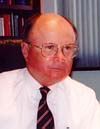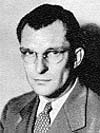 Fred
A. Crawford, M.D., chairman of MUSC’s Department of Surgery,
surgeon-in-chief, and head of the Cardiothoracic Surgery Division, has
been named to the recently endowed Horace D. Smithy Chair of Cardiothoracic
Surgery.
Fred
A. Crawford, M.D., chairman of MUSC’s Department of Surgery,
surgeon-in-chief, and head of the Cardiothoracic Surgery Division, has
been named to the recently endowed Horace D. Smithy Chair of Cardiothoracic
Surgery.
The endowed chair was established from funds bequeathed to MUSC by the Dr. Horace Smithy family at his death in 1948. During the years the money grew and recently was supplemented with a significant gift from Marion, S.C., surgeon Dr. Elliott Finger. It was then designated to honor the memory of Dr. Smithy and his achievements at MUSC nearly 50 years ago.
Since graduating first in his class from Duke University Medical School in 1967, Crawford has devoted himself to academic cardiac surgery.
He has been selected to serve in positions of senior responsibility in national societies. He is chairman of the Cardiac Examination Subcommittee and on the Board of Directors of the American Board of Thoracic Surgery. In the national Society of Thoracic Surgery he has been a councilor, chairman of the National Program Committee and chairman of the Cardiac Credentialing Committee. He has been the American College of Cardiology’s governor for South Carolina and serves on the Board of Directors of the South Carolina Chapter of the American Heart Association.
Crawford has provided leadership at MUSC at the university, college, hospital, and departmental levels. For 18 years he has served with distinction, first as head of the Division of Cardiothoracic Surgery and since 1988, as chairman of the Department of Surgery and surgeon-in-chief, Medical University Hospital.
As president of University Medical Associates from 1989 through 1994 and 1995 through the present, Crawford has led that organization to becoming a corporation which is providing very important and innovative leadership in the university’s transition into managed care.
He has been a contributor in the college’s Strategic Planning Steering Committee, Executive Committee and Change Management Committee. His tenure as chairman of the Department of Surgery has been marked by orderly growth of faculty recruitment, important new patient care programs, financial stability, enhanced student and resident education and development of a growing research program. He is recognized for his leadership in cardiac valvular and arrhythmia surgery.
The quality of his teaching has been recognized by nomination for the Golden Apple Award at Duke and MUSC on three occasions. The surgical residency teaching program which he leads competes nationally with success in attracting the best applicants.
Crawford’s scholarly works include more than 200 publications in both outstanding peer reviewed journals and respected textbooks. He is recognized as providing leadership in the clinical applications of developments in valvular and arrhythmia heart surgery. He serves on the editorial board of the “Journal of Thoracic and Cardiovascular Surgery” and as a reviewer of “Circulation, Chest, Annals of Thoracic Surgery, and Military Medicine.” As chairman of the Cardiac Examination Subcommittee and member of the Board of Directors of the American Board of Thoracic Surgery, he helps set national standards for cardiac surgery.
On Jan. 30, 1948,
a young assistant professor of surgery at MUSC made medical history by
successfully removing scar tissue from the heart of a young incapacitated
girl who had been given but a brief time to live. The technique employed
by the  34-year-old
Horace G. Smithy was based upon two
years of exhaustive research experimentation. His research included the
design of a new instrument, known as a valvulotome, to cut scar tissue
blocking the heart valves of rheumatic fever victims. He subsequently operated
upon six additional patients, four of whom survived.
34-year-old
Horace G. Smithy was based upon two
years of exhaustive research experimentation. His research included the
design of a new instrument, known as a valvulotome, to cut scar tissue
blocking the heart valves of rheumatic fever victims. He subsequently operated
upon six additional patients, four of whom survived.
Tragically, Smithy himself had valvular heart disease as a result of rheumatic fever during childhood, and his condition began rapidly deteriorating in 1948. He requested a noted surgeon at Johns Hopkins Hospital to carry out the procedure on him, but before this could be arranged, Smithy died on Oct. 28, 1948.
Smithy’s premature death deprived Charleston and the Medical University of the opportunity to become an early center for cardiac surgery. However, from his pioneering efforts, enormous progress has been made. Today reliable prosthetic heart valves are widely available and surgery for valvular heart disease is standardized and carries a very low operative risk in most individuals.